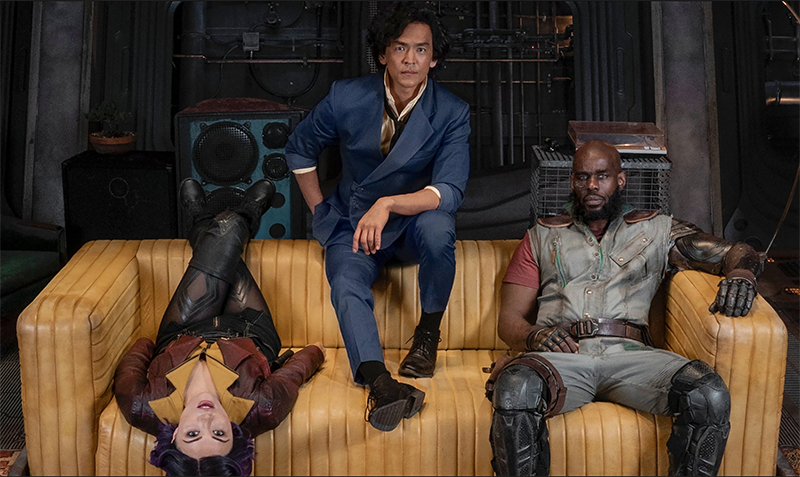Review: Cowboy Bebop (Season One)
Starring: John Cho, Mustafa Shakir, and Daniella Pineda
Cowboy Bebop, Netflix’s long-awaited live-action adaptation of the 1998 anime of the same name, has carried over many aesthetic touches from the original series. Spike, Jet, and Faye are all here, familiarly costumed, living aboard a ship that looks a lot like the one from the cartoon. Their new adventures are largely remixes of tales fans have seen before, and Yoko Kanno’s iconic soundtrack features heavily throughout. The intro, set to Tank! by the Seatbelts, is almost the same; the show even still wraps most episodes with “See You, Space Cowboy”. In many ways, this is distinctly recognisable as being Cowboy Bebop.
But the thing is, this isn’t Cowboy Bebop, not really. This new version mistakes the shortcomings of the original series for artistic flourishes and vice-versa, and in trying to make something new, it misses most of what made the anime work. Your mileage may vary on how much this bothers you: as an adaptation it’s terrible, but it’s also not very good when judged as an original piece.
Cowboy Bebop is set in a near-future where space travel is the norm, and humanity has colonised several planets – but far from being a bright sci-fi future, many of these new worlds are dilapidated and unpleasant. The show follows Spike (John Cho), Jet (Mustafa Shakir) and Faye (Daniella Pineda), a trio of bounty hunters who team up aboard Jet’s ship, the Bebop, to try (and mostly fail) to capture a series of over-the-top criminals.
The original series, despite being an integral entry point into anime for many fans in the late 90s and early 2000s (myself included), is not an untouchable object. It has its share of weaker episodes, aged animations, and shallow characters. But across 26 episodes, it builds up to something great: a subtle story (despite all the bombast) about a ragtag group that just can’t quite figure out how they should live their lives, or how to reconcile their pasts. This new series trades melancholy for melodrama, and its 10-episode first season feels stretched and formless, unsure what it wants to be. It’s hard not to wonder what the showrunners saw as vital in the source material, because this version misses the point.
The show is visually flat, with soft lighting and some dodgy CGI killing the vibe of some otherwise beautiful sets. The fight sequences are cut and edited as though they’re something to be embarrassed by: there are so many fast cuts between characters that you rarely get to see punches land, but the camera makes sure to languish on the violent aftermath of a hard hit, as though the gore is more important than the choreography. Simply put, this is an ugly show. The soundtrack is as glorious as ever, but those hoping for exciting new tracks are out of luck.
The cast, at least, is game. Mustafa Shakir’s Jet is comfortably the highlight; the character has changed quite a bit, but Shakir’s gruff brand of warmth, and his intense stare, is on point. John Cho’s Spike and Daniella Pineda’s Faye are even further removed from their anime counterparts, but each actor brings some energy and verve to their roles, despite some weak writing. Faye’s updated live-action costume is a sensible adjustment, and Cho looks fantastic in Spike’s suit.
Tweaks to character relationships mean that our heroes are now more archetypal, and the show bends over backwards to assure us that they’re a found family: the team’s dynamics have been simplified to the point of cliché. By smoothing off the edges of their uneasy alliances from the original series, a lot of nuance is lost, and the characters have become far less interesting. Vicious and Julia – purposefully mysterious characters in the original series who we learned little about – are now series regulars, and the results are disastrous. Alex Hassell’s Vicious, with his distractingly awful dye job and intense bugging eyes, slows the show right down whenever he appears, and a side plot about his internal conflict with the crime group “The Syndicate” is hammy and awful.
This version of Vicious is disgusting and loathsome, but not compelling. The violence he commits is surprisingly grotesque, and the show uses domestic violence as a stand-in for character development. For a show that feels like it’s aiming for kitsch most of the time, the prevalence and awfulness of these villains is confusing. The bounties the crew pursue feel a little better, but don’t expect any breakout new stars.
Netflix’s Cowboy Bebop never figures out how to be its own thing. A show that developed new plotlines, chased new bounties, and fully reinvented these characters could have been fun. With further tweaks and a name change, it would perhaps attract less vitriol as an innocuously below-average sci-fi show that wore its influences on its sleeve. As an adaptation, its failures are dramatic: Cowboy Bebop focuses so much on squeezing in iconography and winking knowingly at the audience that it struggles to develop any identity of its own.
Cowboy Bebop season one is now streaming on Netflix. The original anime is also available on the streamer; I would recommend watching the latter and skipping the former.
James O’Connor













